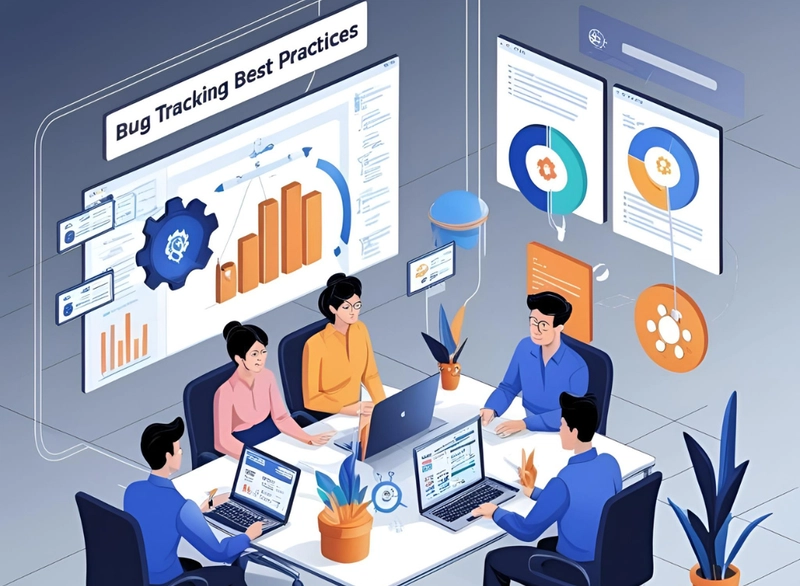In the fast-paced world of software development, efficiency is key. As applications grow more complex and user expectations rise, the ability to identify, track, and resolve bugs quickly has become a critical factor in delivering high-quality software. Enter Genqe.ai, a revolutionary tool that is redefining bug tracking and test efficiency in this new era of software development. In this article, we’ll explore the best practices for bug tracking, the challenges teams face, and how Genqe.ai is transforming the way we approach software testing.
The New Era of Software Development: A Need for Smarter Bug Tracking
The software development landscape has evolved dramatically in recent years. With the rise of agile methodologies, continuous integration/continuous deployment (CI/CD), and AI-driven development, the demand for faster, more efficient testing processes has never been greater. Traditional bug tracking methods, often manual and time-consuming, are no longer sufficient to keep up with the pace of modern development cycles.
Why Bug Tracking Matters
Quality Assurance: Effective bug tracking ensures that issues are identified and resolved before they reach end-users.
Team Collaboration: A centralized bug tracking system improves communication and coordination among developers, testers, and stakeholders.
Project Management: Tracking bugs helps teams prioritize tasks, allocate resources, and meet deadlines.
User Satisfaction: Delivering bug-free software enhances user experience and builds trust in your product.
Common Challenges in Bug Tracking
Despite its importance, bug tracking is often fraught with challenges that can hinder efficiency and effectiveness:
1.Inefficient Workflows
Manual bug tracking processes are slow and prone to errors, leading to delays in identifying and resolving issues.
2.Lack of Visibility
Without a centralized system, it can be difficult to track the status of bugs, leading to miscommunication and duplicated efforts.
3.Poor Prioritization
Not all bugs are created equal. Failing to prioritize critical issues can result in wasted time and resources.
4.Inconsistent Reporting
Inconsistent or incomplete bug reports make it harder for developers to reproduce and fix issues.
5.Integration Gaps
Bug tracking tools that don’t integrate with other development tools can create silos and disrupt workflows.
Introducing Genqe.ai: A New Era of Bug Tracking
In response to these challenges, Genqe.ai has emerged as a game-changing solution for bug tracking and test efficiency. Designed specifically for the new era of software development, Genqe.ai leverages advanced AI and automation to streamline bug tracking and improve team productivity.
Key Features of Genqe.ai
1.Automated Bug Detection
Genqe.ai uses AI-powered algorithms to automatically detect and log bugs during testing. This reduces the manual effort required and ensures that no issue goes unnoticed.
2.Centralized Bug Tracking
The tool provides a centralized platform for tracking bugs, making it easy for teams to collaborate and stay updated on the status of issues.
3.Smart Prioritization
Genqe.ai analyzes the severity and impact of bugs, helping teams prioritize critical issues and allocate resources effectively.
4.Detailed Bug Reports
The tool generates comprehensive bug reports, including steps to reproduce, screenshots, and logs, making it easier for developers to resolve issues.
5.Seamless Integration
Genqe.ai integrates seamlessly with popular development tools, such as CI/CD pipelines, version control systems, and project management platforms, ensuring a smooth workflow.
6.Real-Time Notifications
Teams receive real-time notifications about new bugs and updates, enabling faster response times and reducing delays.
7.Analytics and Insights
Genqe.ai provides detailed analytics and insights into bug trends, helping teams identify recurring issues and improve their testing processes.
Best Practices for Bug Tracking with Genqe.ai
To maximize the benefits of Genqe.ai and improve test efficiency, follow these best practices:
1.Standardize Bug Reporting
Establish clear guidelines for reporting bugs, including required fields and formats. Genqe.ai automated reporting features can help ensure consistency.
2.Prioritize Bugs Effectively
Use Genqe.ai smart prioritization features to focus on critical issues that impact user experience or system functionality.
3.Leverage Automation
Take advantage of Genqe.ai automated bug detection and logging capabilities to reduce manual effort and improve accuracy.
4.Foster Collaboration
Encourage teams to use Genqe.ai centralized platform for communication and collaboration, ensuring everyone is on the same page.
5.Monitor and Analyze Trends
Use Genqe.ai analytics and insights to identify recurring issues and address root causes, improving overall software quality.
6.Integrate with Development Tools
Ensure Genqe.ai is integrated with your existing development tools to create a seamless workflow and avoid silos.
7.Continuously Improve Processes
Regularly review and refine your bug tracking processes based on feedback and insights from Genqe.ai.
How Genqe.ai is Shaping the Future of Bug Tracking
The launch of Genqe.ai marks a significant milestone in the evolution of bug tracking. By combining AI-powered automation, centralized tracking, and seamless integration, Genqe.ai is setting a new standard for efficiency and effectiveness in software testing. Here’s how it’s making an impact:
1.Faster Issue Resolution
Genqe.ai automated bug detection and detailed reporting enable teams to identify and resolve issues faster, reducing development cycles.
2.Improved Collaboration
The tool’s centralized platform fosters better communication and collaboration among teams, leading to more efficient workflows.
3.Enhanced Software Quality
By prioritizing critical issues and providing actionable insights, Genqe.ai helps teams deliver higher-quality software.
4.Scalable Solutions
Genqe.ai is designed to scale with your organization, providing bug tracking solutions for projects of all sizes and complexities.
Conclusion
In this new era of software development, efficient bug tracking is no longer optional — it’s a necessity. Genqe.ai is at the forefront of this transformation, providing the tools and technologies needed to streamline bug tracking, improve test efficiency, and deliver high-quality software. By adopting Genqe.ai, teams can overcome the challenges of traditional bug tracking and embrace a smarter, more efficient approach to software testing. The launch of Genqe.ai is not just a technological advancement — it’s a commitment to shaping the future of software development.





Top comments (0)